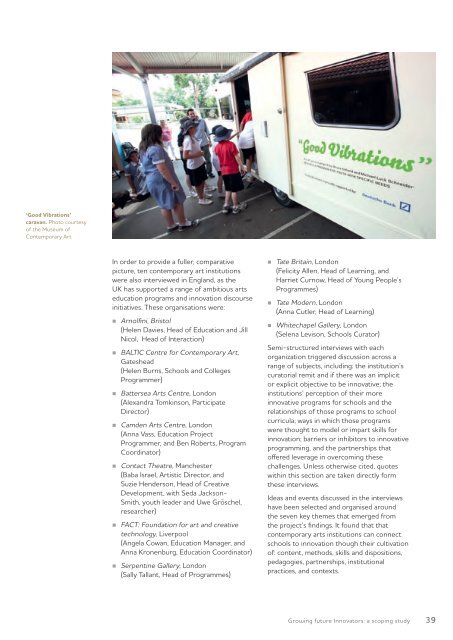GrowinG Future innovators - ARC Centre of Excellence for Creative ...
GrowinG Future innovators - ARC Centre of Excellence for Creative ...
GrowinG Future innovators - ARC Centre of Excellence for Creative ...
Create successful ePaper yourself
Turn your PDF publications into a flip-book with our unique Google optimized e-Paper software.
‘Good Vibrations’<br />
caravan. Photo courtesy<br />
<strong>of</strong> the Museum <strong>of</strong><br />
Contemporary Art<br />
In order to provide a fuller, comparative<br />
picture, ten contemporary art institutions<br />
were also interviewed in England, as the<br />
UK has supported a range <strong>of</strong> ambitious arts<br />
education programs and innovation discourse<br />
initiatives. These organisations were:<br />
Arnolfini, Bristol<br />
(Helen Davies, Head <strong>of</strong> Education and Jill<br />
Nicol, Head <strong>of</strong> Interaction)<br />
BALTIC <strong>Centre</strong> <strong>for</strong> Contemporary Art,<br />
Gateshead<br />
(Helen Burns, Schools and Colleges<br />
Programmer)<br />
Battersea Arts <strong>Centre</strong>, London<br />
(Alexandra Tomkinson, Participate<br />
Director)<br />
Camden Arts <strong>Centre</strong>, London<br />
(Anna Vass, Education Project<br />
Programmer, and Ben Roberts, Program<br />
Coordinator)<br />
Contact Theatre, Manchester<br />
(Baba Israel, Artistic Director, and<br />
Suzie Henderson, Head <strong>of</strong> <strong>Creative</strong><br />
Development, with Seda Jackson-<br />
Smith, youth leader and Uwe Grõschel,<br />
researcher)<br />
FACT: Foundation <strong>for</strong> art and creative<br />
technology, Liverpool<br />
(Angela Cowan, Education Manager, and<br />
Anna Kronenburg, Education Coordinator)<br />
Serpentine Gallery, London<br />
(Sally Tallant, Head <strong>of</strong> Programmes)<br />
Tate Britain, London<br />
(Felicity Allen, Head <strong>of</strong> Learning, and<br />
Harriet Curnow, Head <strong>of</strong> Young People’s<br />
Programmes)<br />
Tate Modern, London<br />
(Anna Cutler, Head <strong>of</strong> Learning)<br />
Whitechapel Gallery, London<br />
(Selena Levison, Schools Curator)<br />
Semi-structured interviews with each<br />
organization triggered discussion across a<br />
range <strong>of</strong> subjects, including: the institution’s<br />
curatorial remit and if there was an implicit<br />
or explicit objective to be innovative; the<br />
institutions’ perception <strong>of</strong> their more<br />
innovative programs <strong>for</strong> schools and the<br />
relationships <strong>of</strong> those programs to school<br />
curricula; ways in which those programs<br />
were thought to model or impart skills <strong>for</strong><br />
innovation; barriers or inhibitors to innovative<br />
programming, and the partnerships that<br />
<strong>of</strong>fered leverage in overcoming these<br />
challenges. Unless otherwise cited, quotes<br />
within this section are taken directly <strong>for</strong>m<br />
these interviews.<br />
Ideas and events discussed in the interviews<br />
have been selected and organised around<br />
the seven key themes that emerged from<br />
the project’s findings. It found that that<br />
contemporary arts institutions can connect<br />
schools to innovation though their cultivation<br />
<strong>of</strong>: content, methods, skills and dispositions,<br />
pedagogies, partnerships, institutional<br />
practices, and contexts.<br />
Growing future Innovators: a scoping study 39




![Plebiscite (Riegert chapter) revised FINAL [Feb 14].pdf](https://img.yumpu.com/8710373/1/190x245/plebiscite-riegert-chapter-revised-final-feb-14pdf.jpg?quality=85)